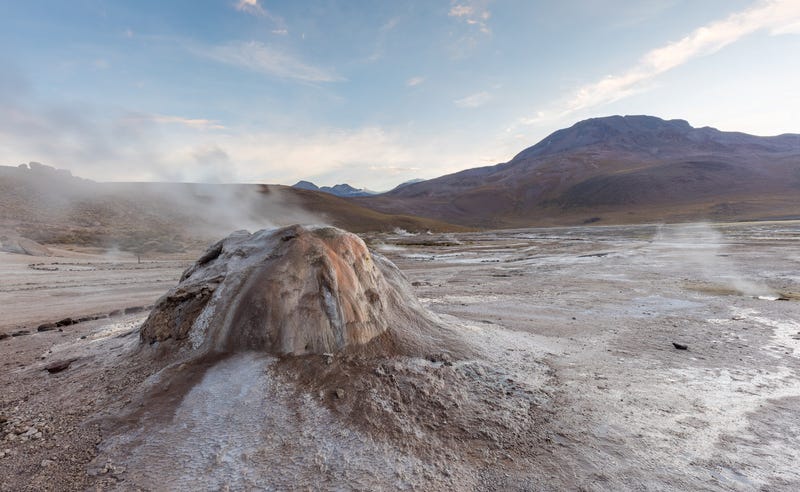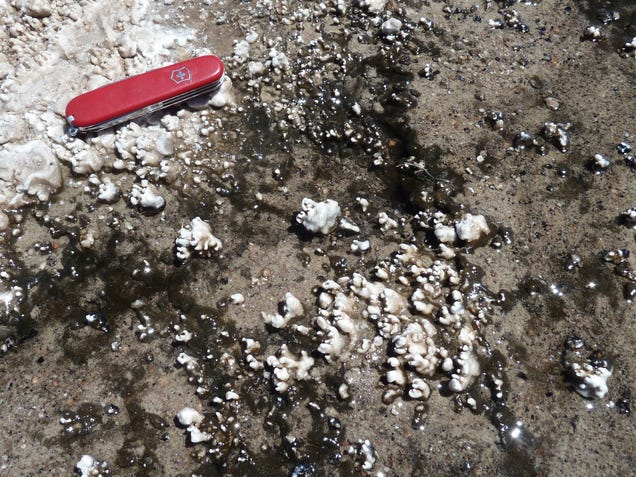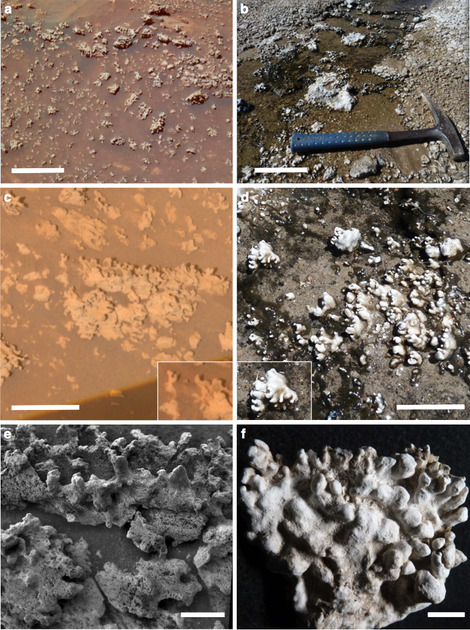NASA Didn't Find Life on Mars—But It Did Find Something Very Cool

Close up of a geyser at El Tatio, a Mars-like environment located high in the mountains of northern Chile.
If we ever get proof of past life on Mars, it’ll come in the form of biosignatures, fingerprints that could only have been left by living organisms. We’re a long way from finding that smoking gun evidence, but an analysis of silica minerals discovered by NASA’s Spirit rover pushes us one step closer. Because of their similarity to silica deposits shaped by microbial life on Earth, these intriguing Martian minerals are now being called a “potential biosignature.”
To be clear, this does not mean NASA has discovered life on Mars. It means that we might have found evidence of past life—which is still pretty damn cool.
A study published last week in Nature Communicationsraises anew the possibility that life once existed on Mars, by drawing a connection between opaline silica deposits found near the “Home Plate” feature in Gusev crater, and opaline silica at El Tatio, a geyser field located high in the Andes mountains of northern Chile. A rubbery-looking substance forming bumpy nodules that lack crystal structure, opaline silica was first discovered on Mars by the Spirit rover in 2007. It’s taken to be evidence of past hydrothermal or volcanic activity.

Opaline silica deposits at El Tatio, Chile. Image: Steve Ruff
“This mineral, opaline silica, can form in various ways,” said Steve Ruff, the planetary scientist at Arizona State University who led the recent study. “It can form around a hot spring or geyser, or in fumaroles,” he added, referring to the steaming vents around volcanoes that spew hot, sulfur-rich gases into the air.
ADVERTISEMENT
Initially, Ruff and his colleagues suspected Spirit’s opaline silica deposits formed billions of years ago, from basaltic rocks that were leached by sulfuric acid pouring out of fumaroles. But as they continued to analyze Spirit’s data, the scientists began to favor another possibility: opaline silicate precipitating out of hot, mineral-rich waters. After Spirit became stuck in a rut in 2009, and died in 2010, there was no way prove one scenario or the other.

Comparison of opaline silica structures found on Mars (left panels) and El Tatio (right panel) at various scales. a-b scale bar represents 10 cm, c-d scalebar represents 5 cm, and e-f scale bar represents 1cm. Image: Ruff and Farmer 2016
A few years back, Ruff got a new lead. Reading a volcanology paper, he came across a reference to El Tatio, a vast Chilean hydrothermal system located 14,000 feet above sea level, where hot spring and geyser channels contain deposits of opaline silica. Excitingly, many of the silica deposits at El Tatio bore striking similarity to those in Gusev crater, and the cold, arid environment seemed pretty Mars-like, too.
To learn more about what’s shaping opaline silica minerals on Earth, Ruff and his colleague Jack Farmer traveled to El Tatio to survey the environment and collect samples for spectral analysis and high-resolution imaging. They learned that silica minerals at El Tatio form in shallow, hydrothermal waters—and that the deposits most closely resembling the Martian ones occur in the presence of microbes.
Specifically, opaline silica deposits featuring the clumpy nodules and tiny, finger-like structures seen on Mars tend to form alongside sticky mats of microorganisms, called biofilms. In some environments, microbes will actively trigger mineral formation, but that doesn’t seem to be the case at El Tatio.
“At this point, we can say it’s a passive process,” Ruff said. “These microbial matts form in shallow water, and they start connecting to what’s there—which is silica nodules. As they’re clinging onto these nodules, they’re becoming coated in silica.”
From the looks of it, the finger-like structures at El Tatio form as colonies of microbes try to escape death, growing their biofilm away from silica minerals, only to eventually become entombed. Which raises an intriguing question: If the opaline silica on Mars formed in a similar environment, is made of the same stuff and takes on the same shape, was it formed in the same way?
We won’t know the answer unless we send another rover to Gusev crater, collect samples, bring those sample back to Earth, and analyze them using fancy electron microscopes. (The next US rover to Mars, in 2020, will collect samples for a return mission, but its landing location has not yet been determined.) Only if scientists can show that the silica structures on Mars and Earth are a microscopic match can they say they’ve found a true biosignature.
Or not. “In my opinion, [these deposits] could very well be due to abiotic reactions and are only a ‘potential biosignature,’” Rocco Mancinelli, an astrobiologist at NASA’s Ames Research Center who was not involved with the study told Gizmodo. “My guess is that this is an abiotic phenomenon.”

No hay comentarios:
Publicar un comentario